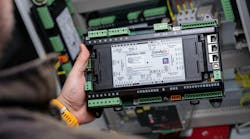Data Center Insights: Zech Connell of BluePrint Supply Chain
The Data Center Frontier Executive Roundtable features insights from industry executives with lengthy experience in the data center industry. Here’s a look at the insights from Zech Connell, VP, Program Development, BluePrint Supply Chain.
Zech Connell currently serves as the Vice President of Program Development at BluePrint Supply Chain, a role he assumed in September 2022. With over a year and four months in this position, Connell plays a pivotal role in steering the company's growth and development.
Connell sits on the company's leadership team where his department is responsible for overseeing revenue, profitability, growth, marketing, and partner retention and satisfaction. In this capacity, Connell and his team focus on delivering innovative solutions, positioning BluePrint as an extension of its partners. Their goal is to fortify, scale, and build resilient construction supply chains, seamlessly integrating the delivery of offsite constructed products from manufacturers to construction site foundations.
Following his bachelor’s degree in business marketing from Oral Roberts University, Connell has demonstrated his expertise in development and operations within renowned companies such as BluePrint Supply Chain, ProLift Rigging, and Barnhart Crane & Rigging where he has had the opportunity to serve the data center, nuclear, refining, chemical, and manufacturing verticals.
When he is not successfully delivering critical OFCI equipment to customer sites, Connell can be found in his home gym.
Here's the full text of Zech Connell's insights from our Executive Roundtable:
Data Center Frontier: After this landmark year of unprecedented anticipation for artificial intelligence and machine learning (AI/ML) technologies amid escalating requirements in the traditional cloud, the data center sector is poised to experience even greater urgency of demand. As we proceed into a widely forecasted “new twenty-year cycle" of growth, what will be the most key factors for enabling the industry’s ability to meet such demand next year and beyond? What persistent challenges stand most to inhibit this ability?
Zech Connell, BluePrint Supply Chain: Growth will continue to accelerate, with manufacturing and construction speeds remaining the primary rate-controlling factors.
Given that we are an organization that specializes in industrial supply chain management, we have a unique perspective on the factors that have the greatest impact on project timelines.
The industry requires more gear to be produced at a faster rate with a more efficient supply chain infrastructure.
The industry needs more unique NA manufacturing and integrating partners, bringing Tier one and Tier two products closer to construction site demand.
Providers also need strategic supply chain partners to help establish these unique relationships and ultimately deliver gear from manufacturers to construction sites in a more efficient and controlled manner, executing on all touchpoints, from vendor management, visibility, storage, delivery, and setting.
The increase in demand has exceeded the capacity of traditional infrastructure deployment methods to efficiently support it, and this will continue to challenge project timelines and milestones well into 2024 and beyond.
Data Center Frontier: Especially in dense urban markets facing slim availability of critical land and power stakes, "adaptive reuse" of vacant office, retail and other commercial real estate properties for data center design and construction development remains a gathering trend in North America. For investors and providers thinking of adapting a site for reuse as data centers, what makes a particular property a better or worse candidate? And what are the relative considerations for brownfield vs. retrofit development in such cases?
Zech Connell, BluePrint Supply Chain: From our perspective, urban areas add a layer of complexity to construction management.
Physical and environmental risks to project execution are greater in urban areas. Even simple things like large load entrance and egress can be severely restricted in an urban setting.
Every type of building will not meet the structural requirements of a data center. Typically, a commercial office, distribution facility, or manufacturing facility is your best bet.
Brownfield options, while often increasing transportation distance, tend to be less risky and provide construction teams with more space to work with.
When a building is repurposed rather than constructed from the ground up, the space is typically delivered in less time. However, jurisdictions must be considered, as many now have zoning laws that include data center-specific requirements.
Data Center Frontier: The range of available and proposed technologies to remediate looming need for sustainable onsite energy generation at large data center campuses ranges from still barely-within-reach SMR and green hydrogen speculation, to possibly more readily feasible and pragmatic means including renewable microgrids, clean fuel cells, and more efficient generator and battery practices and technologies. Which onsite power generation solutions present the best outlook for investors, developers and providers seeking to balance short- and long-term ROI considerations with the industry’s clear and present drive toward sustainability?
Zech Connell, BluePrint Supply Chain: Whatever can be produced quickly is sufficient in our opinion.
Both the demand and the money are in the present. Today's problems must be addressed without compromising efforts to create a more sustainable tomorrow.
If an option becomes too distant due to manufacturing capacity constraints or other supply chain disruptions, it risks being rendered obsolete by the breakneck pace of innovation, or being deemed too unwieldy due to the rapid emergence of a more available and accessible technology.
Data Center Frontier: For providers of equipment to the North American data center industry looking to bring supply chains for critical infrastructure closer to their customers, what are the main opportunities going into 2024, geographical and otherwise, for an expansion of U.S. manufacturing capabilities?
Zech Connell, BluePrint Supply Chain: Project owners and equipment manufacturers must streamline and optimize their industrial supply chains.
On the one hand, we need to improve the availability and transport time of raw materials and component parts.
Manufacturers and integrators require greater coordination and cooperative demand planning to ensure a constant and reliable flow of mission-critical materials and components.
Supply chain companies, on the other hand, must improve their efficiency by implementing technology to improve visibility, choosing fewer, more stable channel partners, and establishing a system of common operating and metrics standards.
Essentially, better planning and management can improve the lives of all demand ribbon constituents.
About the Author
Matt Vincent
A B2B technology journalist and editor with more than two decades of experience, Matt Vincent is Editor in Chief of Data Center Frontier.



